If the first question that pops into your head when you hear the word kayak is “Won’t it capsize?”, then we are sorry to say that you have been reading the wrong guides all along.
Yes, kayaking might seem very risky at times, but a major portion of your safety is not determined by the activity itself, but the vessel you invest into.
A popular argument between pro and anti-kayakers revolves around the safety of inflatable kayaks. “Are inflatable kayaks safe”? Some will say they are not, while others will argue that they are. But how do you know which argument is valid and true to its words?
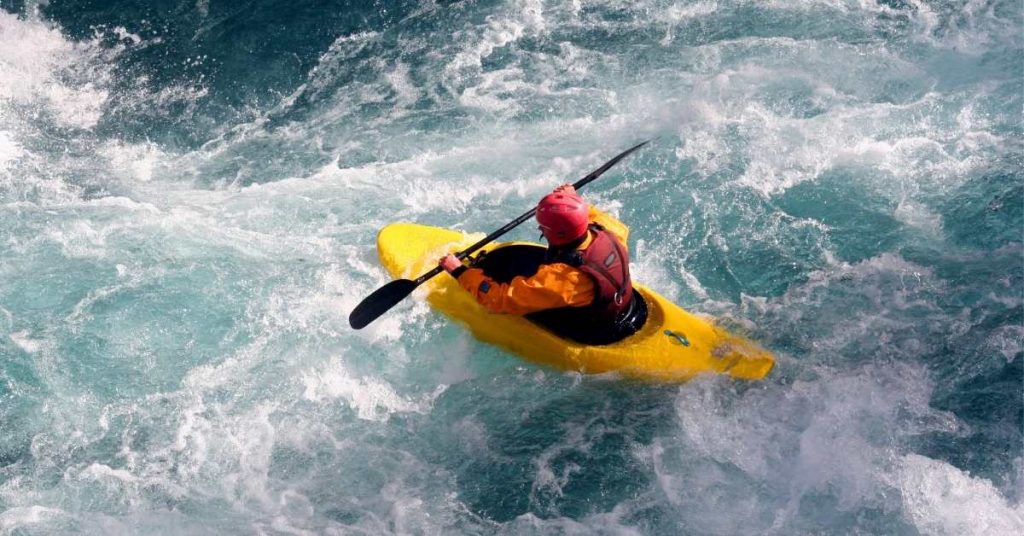
After completing thorough research ourselves, we have decided to conclude this short yet informational article for you, in hopes of decoding the mystery behind this controversial question, once and for all.
So without further ado, let us get right into the discussion!
Watch this for inflatable kayak and how to kayaking
Are inflatable kayaks safe in the sea?
Table of Contents
First and foremost, inflatable kayaks are safe to some extent in the sea. This highly depends on the pressure and flow of the water in the sea.
While out to buy inflatable kayaks, check out which manufacturer’s state the kind of water you can ride on with that specific product. Most inflatable kayaks are meant solely for the purpose of rowing on still and shallow water bodies, such as on lakes, rivers and maybe shallow rapids.
Seas might have a lesser number of rocks and boulders lying around, but this factor still does not make it completely safe for an inflatable kayak.
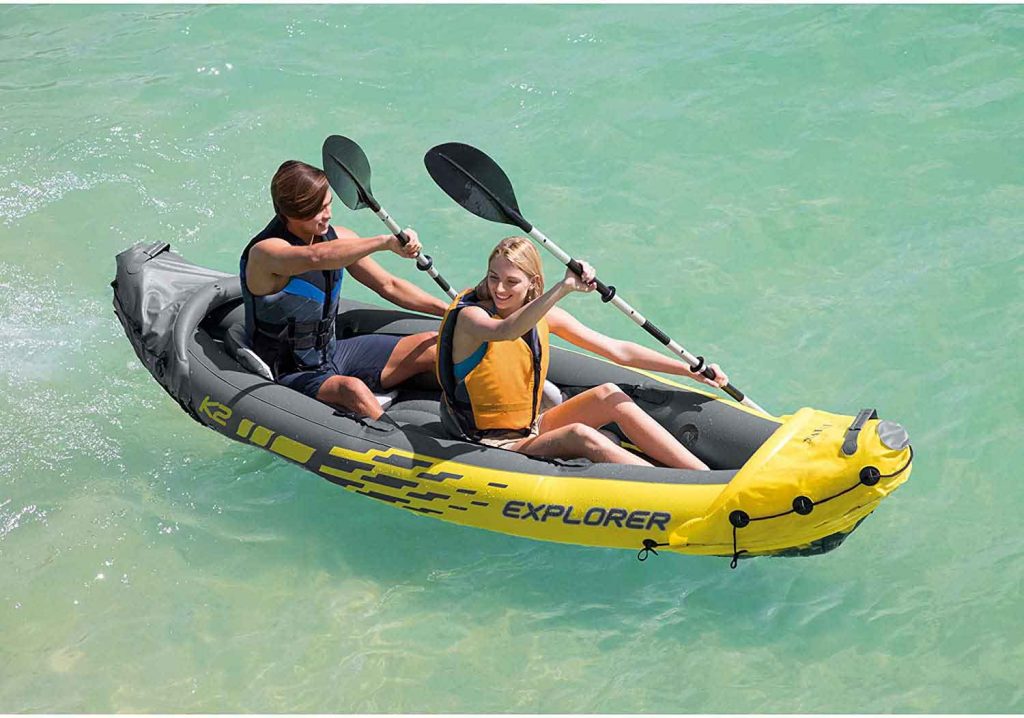
The flow and pressure of water in the sea is definitely much higher than the flow and pressure in the rivers and lakes. On top of that, your built and physique will also determine if you can use an inflatable kayak on sea water in the first place or not.
Wooden kayaks will have no problem in being rowed on sea water or faster rapids, however we would like you to refrain from taking your inflatable kayak out to the sea as it could still risk your safety.
How safe are inflatable kayaks?
Judging from an overall basis, inflatable kayaks are actually very safe. But their safety and endurance on water actually depends on the kind of water body you will be rowing on.
An inflatable kayak is perfectly safe to be used on shallow and soft water, but you should try to not make use of it on rough water. Rough water means bodies with large and strong currents.

Kayaks in general are very light weight, so you can only imagine how light an inflatable one would be. This is why you should not use an inflatable kayak on rough water, as the vessel will be more prone to capsizing and tipping over.
If you really want to use an inflatable kayak on rough water, we suggest you to first contact the manufacturer or customer service of the product and ask if the product is eligible and safe to be used on such rapids.
Are inflatable kayaks good?
Yes, absolutely. Inflatable kayaks are obviously very good and will provide you optimal performance for a very long time. In order to make it last you for a long time, you should maintain it in a proper way as well.

Try not to use your inflatable kayak on water bodies it is not meant for. Use your inflatable kayak on rough waters and rapids only if the product description attached to the kayak you purchase states so in the first place.
But other than that, inflatable kayaks are very good and will perform accurately as long as you take good care of them. Make sure to not row the vessel around tight corners or edges where you know debris or sharp rocks could be in abundance.
No matter how high quality an inflatable kayak is, it will still be prone to popping and being punctured if you force it into dangerous situations.
How long do inflatable kayaks last for?
With proper care and the right storage system, you can make an inflatable kayak last you for more than a year or two. However, since this kind of product relies mostly on air pumps and inflation, an inflatable kayak can still get damaged if something happens to the inflation vaults.
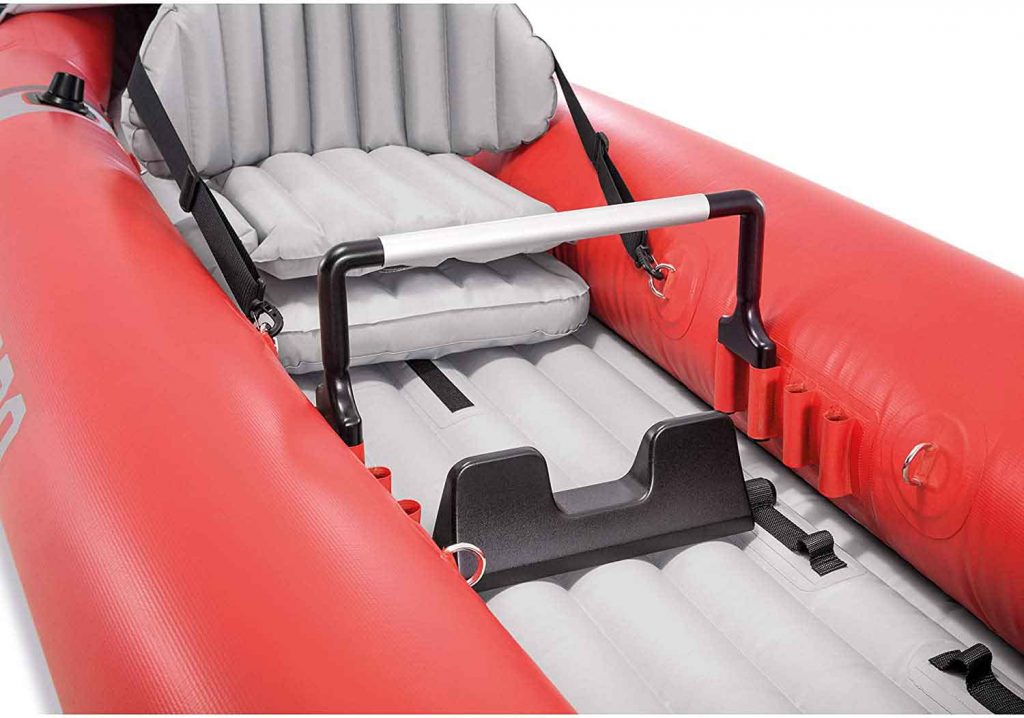
The inflation vault is what will help you inflate or deflate the kayak, so without a functioning valve system, you will basically be stuck with a useless inflatable kayak.
Are inflatable kayaks durable?
Yes, inflatable kayaks are very durable, as long as you do not force them into risky and dangerous situations. An inflatable kayak can last you for a very, very long time with proper and careful maintenance.

Make sure to always clean and inspect your inflatable kayak for holes and punctures. Early detection of accidents will allow you to fix your inflatable kayak and save it from being totally damaged in the long run.
Stability and Rigidity
A lot of people have the misconception of an inflatable kayak being flimsy and weak, but we beg to differ here. An inflatable kayak is similar to any other kayak, with the only difference being that it can be inflated and deflated upon will.
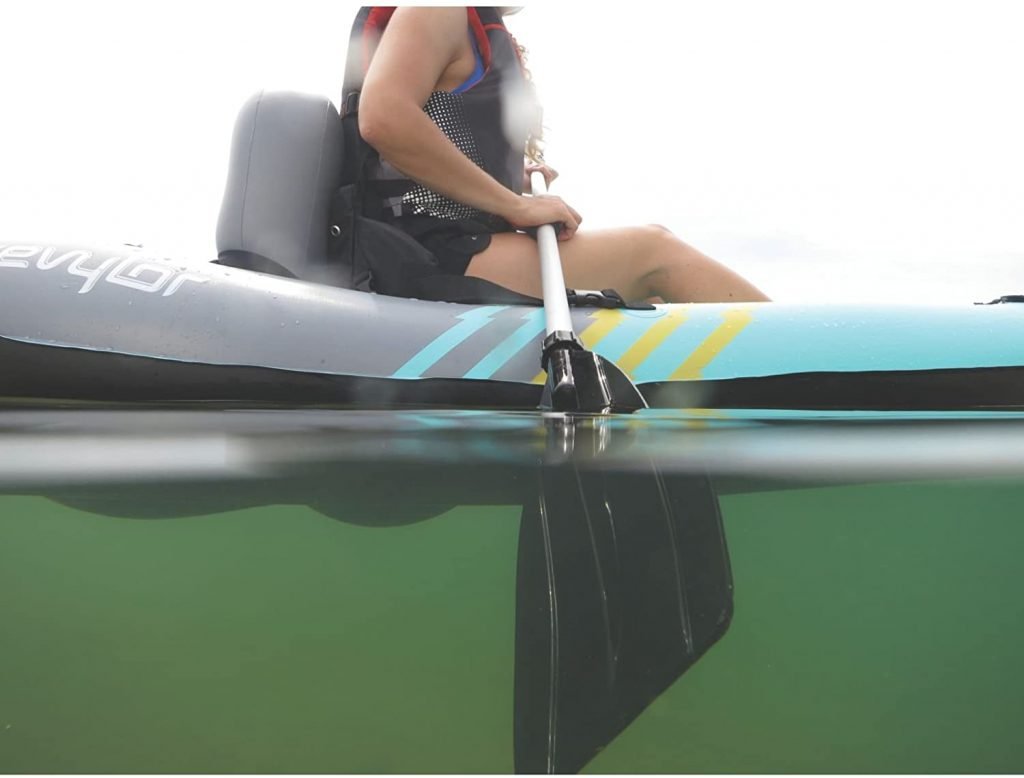
Just like every other kayak, you can expect the best stability and rigidity from inflatable kayaks as well. Granted, the balance in an inflatable kayak cannot be compared to that of a wooden one, but it is still worth noting.
If inflatable kayaks were not stable at all, then people would not be flocking to the markets to purchase them now and then.
However, you cannot exactly stand on an inflatable kayak. Similar to other kayaks of different and more rigid materials, an inflatable kayak can also be quite difficult to get into.
In order to not fall off while stepping onto the kayak in the beginning, we suggest you to do so with the help of a guide or someone else. If there is no one around, do it against a boulder or tree, in order to give yourself some leverage while embarking on the product.
Do inflatable kayaks pop or puncture easily?
In all honesty, yes they do. However, this also depends on the quality, model and brand of the kayak as well.
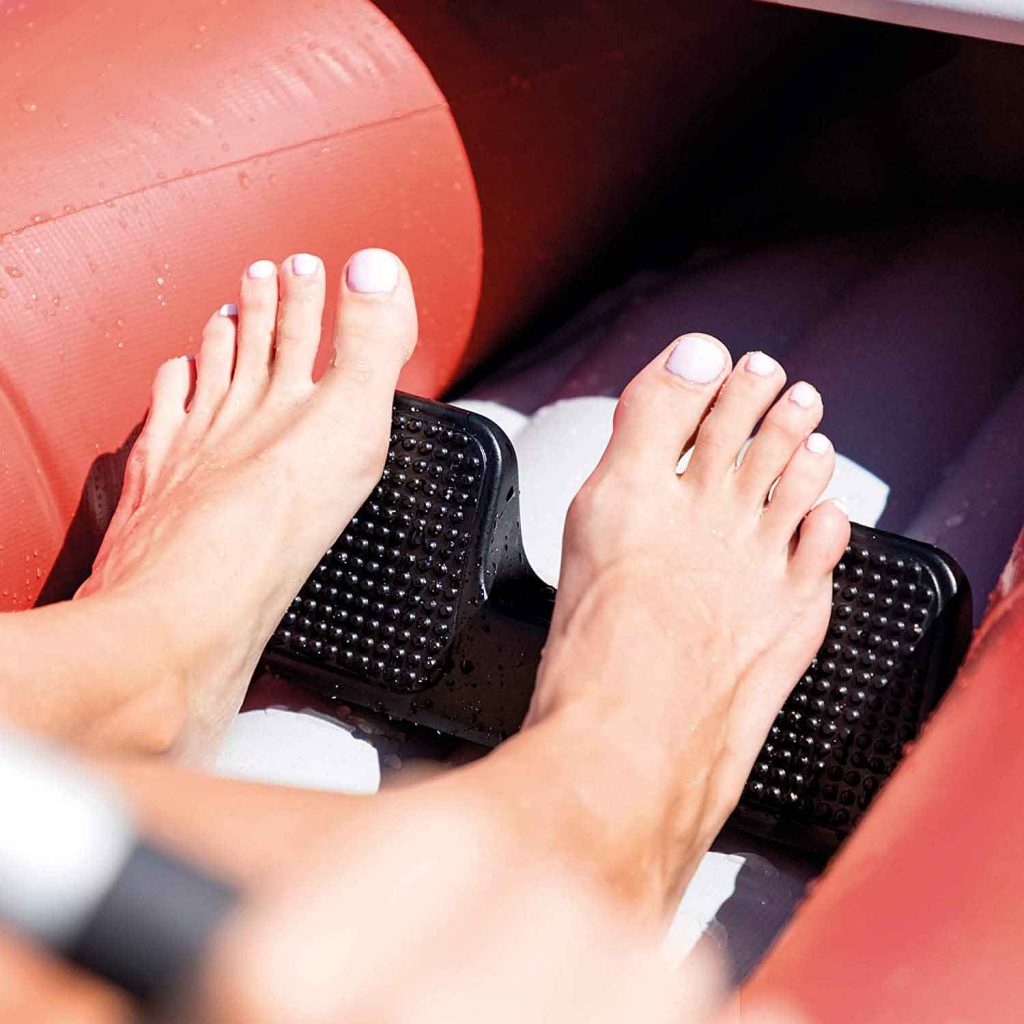
You can find tons of high-end inflatable kayaks being punctured easily in the market. This is because even though the price tag attached to it is high end, the quality is crappy. As a result, you will not be able to enjoy riding on that kayak for a long period of time.
However, a budget friendly inflatable kayak can easily last you for more than a year straight, only due to its high quality and rigidity.
You should always go for either strong synthetic or polyethylene inflatable kayaks as these two materials are the most sought after ones. The material is light weight, hence allowing you optimal portability and mobility at all times, without necessarily posing a threat to your safety.
Another great material used for the construction of inflatable kayaks these days is PVC plastic. These material is not as cheap as the previously mentioned two, so inflatable kayaks constructed of this material might also fall on the pricier end of the spectrum. However, you can expect only the best performance, stability and rigidity from this quality of kayak.
Make sure to always check out if the inflatable kayak you are interested in comes with I-beam tubes or not. I-beam tubes on the floor will allow better balance and stability at all times, thus making it easier for you to get on and off the kayak once on the shore.
Will they sink?
Unlike wooden kayaks, inflatable kayaks will not completely sink as they will still float to some extent. However, if punctured too much and water seeps in large amounts, you can still sink with the inflatable kayak. It is very important for you to steer clear of large boulders and sharp rocks when riding on an inflatable kayak, just to keep yourself safe from impending accidents.
In case of your inflatable kayak sinking into the water, make sure to quickly detect where the puncture is and stop it with some tape or sealant as soon as possible. Even though this will not really fix your kayak, it will still give you some time to come up with a game plan or attract attention to your kayak.
Safety precautions for inflatable kayaks
Like every other sport, you should also practice strict safety measures whenever you head out into the rapids with your inflatable kayak-
- Always steer clear of large and sharp objects, such as rocks and tree branches. Even though most inflatable kayaks come with the necessary padding and built to ward off holes and punctures from forming, it is still a good idea to avoid risking yourself in the first place
- Wear protective gear at all times. By this, we mean wearing a strong helmet, protective goggles over your eyes, durable elbow and knee pads as well as the necessary outfit. Try not to wear sandals while kayaking as it is not a really appropriate choice of footwear
- Whenever you feel that you are starting to sink or that your inflatable kayak is losing air, start to shout for help without moving too much. Chances are, a river guide or passerby will spot you from the distance. In case no one is around in the vicinity, put on your emergency vest and pull yourself out from the cockpit of the kayak as soon as possible
- Whenever investing into an inflatable kayak, make sure to always go for brightly colored ones. A bright colored kayak, such as in shades of neon yellow, electric blue or green will allow people from afar to spot you much more easily. Try not to go for inflatable kayaks in shades of only white, black or dark blue, as that might camouflage you with your surroundings
- Always carry first aid and flashes with you whenever you know you will be travelling upstream and afar. You might never need to use them (and that is what you should want), but it does not hurt to come prepared in case of an emergency or accident, right?
- Do not carry stuff more than the amount of capacity the kayak can withstand. Generally speaking, inflatable kayaks can easily accommodate up to 500 pounds without showing any issues, but it is still a good idea to not push the capacity. You need to remember that your own weight will put a lot of effect on the kayak itself, so bringing unnecessary gears and equipment’s might only tip the kayak into the water.
You may also like-What piece of safety equipment is required on every canoe and kayak?
Final Thoughts
Whether you own an inflatable kayak or a wooden one, the safety precautions required to take into account and maintenance of the product should be the same. An inflatable kayak is by no means dangerous, weak or flimsy. The only downside to it is its low weight capacity, yet the amount stated on the kayaks are still quite noteworthy.
Try not to push the limits of your inflatable kayak and treat it in a way to make it last for a pretty long time. The best thing about an inflatable kayak is its light weight built and portability, so try to enjoy the best experience out of it, without necessarily putting yourself or the kayak in risk.
We really hope you found our article (Is an inflatable kayak safe) to be satisfactory and that it helped you in deciding whether you want an inflatable kayak or not. Remember to always maintain proper caution when rowing the kayak on rough water (if allowed to) and check it thoroughly for leaks and punctures afterwards. We hope the next time you go kayaking, you will remember the safety measures we summed up just for you.
Thank you for sticking around with us until the very end. Good luck on your next kayaking endeavors!
Your point of view caught my eye and was very interesting. Thanks. I have a question for you. https://accounts.binance.com/en-IN/register?ref=UM6SMJM3
Thank you for your sharing. I am worried that I lack creative ideas. It is your article that makes me full of hope. Thank you. But, I have a question, can you help me?
Thank you for your sharing. I am worried that I lack creative ideas. It is your article that makes me full of hope. Thank you. But, I have a question, can you help me? https://accounts.binance.com/es/register?ref=T7KCZASX
I don’t think the title of your article matches the content lol. Just kidding, mainly because I had some doubts after reading the article.
Thanks for sharing. I read many of your blog posts, cool, your blog is very good. https://www.binance.com/sl/register?ref=OMM3XK51
Your point of view caught my eye and was very interesting. Thanks. I have a question for you.
Can you be more specific about the content of your article? After reading it, I still have some doubts. Hope you can help me.
Can you be more specific about the content of your article? After reading it, I still have some doubts. Hope you can help me.
Your point of view caught my eye and was very interesting. Thanks. I have a question for you.
Thank you for your sharing. I am worried that I lack creative ideas. It is your article that makes me full of hope. Thank you. But, I have a question, can you help me?
Thank you for your sharing. I am worried that I lack creative ideas. It is your article that makes me full of hope. Thank you. But, I have a question, can you help me?
гарантия при продаже аккаунтов маркетплейс аккаунтов соцсетей
купить аккаунт площадка для продажи аккаунтов
продать аккаунт https://magazin-akkauntov-online.ru/
профиль с подписчиками маркетплейс аккаунтов соцсетей
маркетплейс аккаунтов маркетплейс для реселлеров
площадка для продажи аккаунтов продажа аккаунтов
платформа для покупки аккаунтов платформа для покупки аккаунтов
Buy Pre-made Account Website for Buying Accounts
Account Selling Service Purchase Ready-Made Accounts
Buy accounts Accounts for Sale
Marketplace for Ready-Made Accounts Buy Pre-made Account
Purchase Ready-Made Accounts Account Trading
Ready-Made Accounts for Sale Account Sale
Account Catalog Purchase Ready-Made Accounts
Buy Account Account Trading Service
Sell Account Secure Account Sales
Verified Accounts for Sale Account Buying Service
account catalog accounts marketplace
accounts for sale account catalog
account market socialaccountssale.com
marketplace for ready-made accounts online account store
ready-made accounts for sale online account store
gaming account marketplace buy accounts
secure account purchasing platform account trading service
account marketplace accountsmarketdiscount.com
account buying platform discountaccountsmarket.com
buy account find accounts for sale
account trading service purchase ready-made accounts
buy and sell accounts accounts marketplace
account marketplace website for buying accounts
accounts market account trading platform
marketplace for ready-made accounts account sale
accounts marketplace account trading service
account buying service accounts market
Thank you for your sharing. I am worried that I lack creative ideas. It is your article that makes me full of hope. Thank you. But, I have a question, can you help me?
buy accounts account purchase
account marketplace account trading platform
buy accounts buy account
account selling service account exchange service
secure account purchasing platform online account store
account selling platform account market
accounts marketplace account buying platform
account trading service buy account
account trading social media account marketplace
buy and sell accounts account trading platform
buy accounts guaranteed accounts
I don’t think the title of your article matches the content lol. Just kidding, mainly because I had some doubts after reading the article.
buy and sell accounts https://accounts-offer.org
marketplace for ready-made accounts https://accounts-marketplace.xyz/
account buying service https://buy-best-accounts.org
account sale https://social-accounts-marketplaces.live
account catalog https://accounts-marketplace.live
social media account marketplace https://social-accounts-marketplace.xyz
website for selling accounts https://buy-accounts.space
account buying service https://buy-accounts-shop.pro
guaranteed accounts https://buy-accounts.live/
account market https://social-accounts-marketplace.live/
sell account https://accounts-marketplace.online
website for selling accounts https://accounts-marketplace-best.pro
покупка аккаунтов https://akkaunty-na-prodazhu.pro/
маркетплейс аккаунтов маркетплейсов аккаунтов
купить аккаунт https://kupit-akkaunt.xyz/
магазин аккаунтов akkaunt-magazin.online
маркетплейс аккаунтов https://akkaunty-market.live/
биржа аккаунтов kupit-akkaunty-market.xyz
покупка аккаунтов akkaunty-optom.live
купить аккаунт купить аккаунт
маркетплейс аккаунтов соцсетей akkaunty-dlya-prodazhi.pro
продать аккаунт магазины аккаунтов
buy a facebook account buy accounts facebook
buy ad account facebook https://buy-ad-accounts.click
buy fb ad account https://buy-ad-account.top/
buying facebook accounts buy accounts facebook
buy facebook old accounts https://ad-account-buy.top
buying facebook ad account fb account for sale
buy aged facebook ads account buying facebook ad account
buy ad account facebook buy facebook account for ads
facebook accounts for sale https://ad-accounts-for-sale.work
google ads agency accounts https://buy-ads-account.top
buy google ad account google ads reseller
buy facebook ad accounts buy facebook ads manager
buy google adwords accounts https://ads-account-for-sale.top
buy verified google ads account https://ads-account-buy.work
buy verified google ads accounts https://buy-ads-invoice-account.top
google ads account seller buy verified google ads account
google ads agency accounts https://buy-ads-agency-account.top
Thank you for your sharing. I am worried that I lack creative ideas. It is your article that makes me full of hope. Thank you. But, I have a question, can you help me? https://accounts.binance.info/register?ref=P9L9FQKY
sell google ads account https://sell-ads-account.click
buy google ads accounts https://ads-agency-account-buy.click
buy facebook business managers https://buy-business-manager.org
buy google adwords account google ads account seller
I don’t think the title of your article matches the content lol. Just kidding, mainly because I had some doubts after reading the article.
buy facebook bm facebook bm for sale
buy business manager facebook buy-business-manager-acc.org
verified bm https://buy-verified-business-manager-account.org/
facebook bm account facebook bm account buy
fb bussiness manager business-manager-for-sale.org
facebook business manager for sale buy facebook verified business account
buy verified business manager facebook buy-bm.org
buy facebook bm account https://verified-business-manager-for-sale.org/
buy facebook business manager account buy-business-manager-accounts.org
tiktok ad accounts https://buy-tiktok-ads-account.org
buy tiktok ads accounts https://tiktok-ads-account-buy.org
buy tiktok ad account https://tiktok-ads-account-for-sale.org
buy tiktok ads https://tiktok-agency-account-for-sale.org
tiktok ads agency account https://buy-tiktok-ad-account.org
tiktok agency account for sale https://buy-tiktok-ads-accounts.org
buy tiktok ads account https://buy-tiktok-business-account.org
Thanks for sharing. I read many of your blog posts, cool, your blog is very good.
buy tiktok ads accounts https://tiktok-ads-agency-account.org
buy tiktok business account https://buy-tiktok-ads.org
Thank you for your sharing. I am worried that I lack creative ideas. It is your article that makes me full of hope. Thank you. But, I have a question, can you help me?
Your point of view caught my eye and was very interesting. Thanks. I have a question for you.
Your point of view caught my eye and was very interesting. Thanks. I have a question for you.
Your article helped me a lot, is there any more related content? Thanks!
fb account for sale sell account account acquisition
facebook ad account buy buy accounts buy and sell accounts
Thank you for your sharing. I am worried that I lack creative ideas. It is your article that makes me full of hope. Thank you. But, I have a question, can you help me?
Эта статья сочетает в себе как полезные, так и интересные сведения, которые обогатят ваше понимание насущных тем. Мы предлагаем практические советы и рекомендации, которые легко внедрить в повседневную жизнь. Узнайте, как улучшить свои навыки и обогатить свой опыт с помощью простых, но эффективных решений.
Получить дополнительную информацию – https://quick-vyvod-iz-zapoya-1.ru/
Your point of view caught my eye and was very interesting. Thanks. I have a question for you.
Your point of view caught my eye and was very interesting. Thanks. I have a question for you.
Thank you for your sharing. I am worried that I lack creative ideas. It is your article that makes me full of hope. Thank you. But, I have a question, can you help me?
Luxury property expertise, luxury living properly maintained. Premium service premium results. Luxury living perfected.
Dry Cleaning in New York city by Sparkly Maid NYC
Your article helped me a lot, is there any more related content? Thanks!
Thanks for sharing. I read many of your blog posts, cool, your blog is very good. https://www.binance.info/en-IN/register?ref=UM6SMJM3
Can you be more specific about the content of your article? After reading it, I still have some doubts. Hope you can help me.